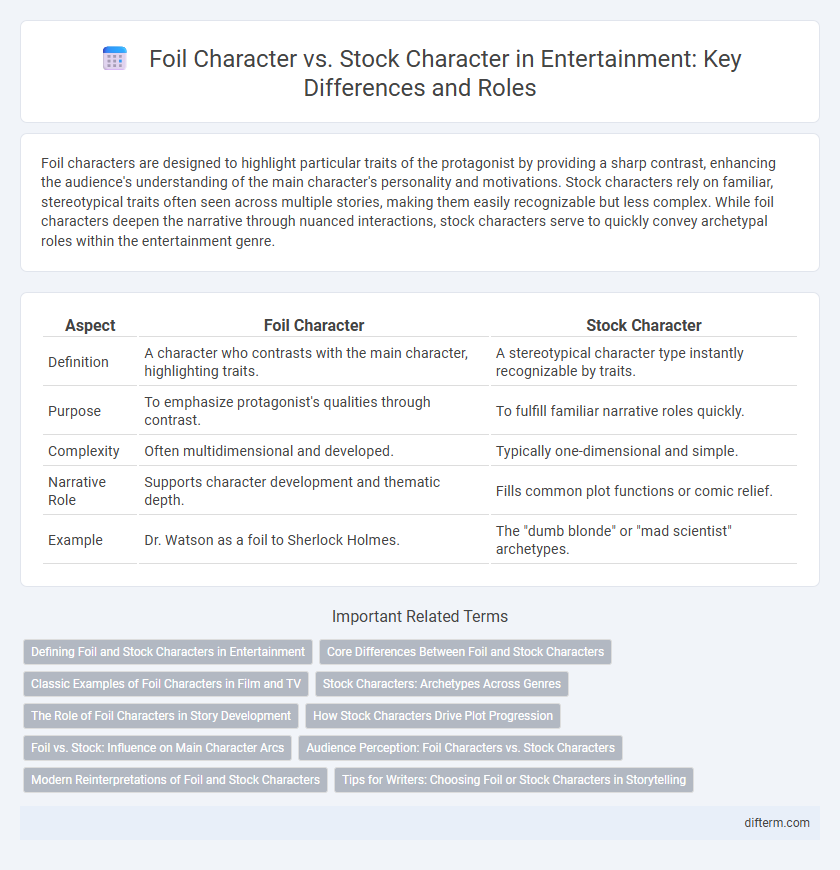Foil characters are designed to highlight particular traits of the protagonist by providing a sharp contrast, enhancing the audience's understanding of the main character's personality and motivations. Stock characters rely on familiar, stereotypical traits often seen across multiple stories, making them easily recognizable but less complex. While foil characters deepen the narrative through nuanced interactions, stock characters serve to quickly convey archetypal roles within the entertainment genre.
Table of Comparison
| Aspect | Foil Character | Stock Character |
|---|---|---|
| Definition | A character who contrasts with the main character, highlighting traits. | A stereotypical character type instantly recognizable by traits. |
| Purpose | To emphasize protagonist's qualities through contrast. | To fulfill familiar narrative roles quickly. |
| Complexity | Often multidimensional and developed. | Typically one-dimensional and simple. |
| Narrative Role | Supports character development and thematic depth. | Fills common plot functions or comic relief. |
| Example | Dr. Watson as a foil to Sherlock Holmes. | The "dumb blonde" or "mad scientist" archetypes. |
Defining Foil and Stock Characters in Entertainment
Foil characters in entertainment serve to highlight the traits of the main characters through contrasting qualities, deepening the audience's understanding of their personalities and motivations. Stock characters are stereotypical figures easily recognized by audiences, often embodying conventional traits like the hero, villain, or sidekick, which provide familiarity and predictability in storytelling. Both foil and stock characters play crucial roles in narrative structure by enriching character dynamics and advancing plot development.
Core Differences Between Foil and Stock Characters
Foil characters are designed to highlight specific traits of the protagonist through contrast, enriching character development and thematic depth. Stock characters represent fixed, recognizable types that embody common stereotypes, often lacking complexity and growth. The core difference lies in foil characters' purpose to enhance characterization, while stock characters serve to fulfill familiar, predictable roles within a narrative.
Classic Examples of Foil Characters in Film and TV
In film and TV, classic foil characters such as Dr. Watson to Sherlock Holmes exemplify contrasting traits that highlight the protagonist's unique qualities. Another iconic example includes Draco Malfoy opposing Harry Potter, emphasizing themes of rivalry and moral choices. These foils deepen narrative complexity by providing a direct comparison that sharpens the audience's understanding of the main characters.
Stock Characters: Archetypes Across Genres
Stock characters serve as foundational archetypes across genres, embodying easily recognizable traits that quickly convey roles and motivations to the audience. These archetypes, such as the Hero, Villain, or Damsel in Distress, offer narrative efficiency by providing familiar and predictable character functions that support plot development. Their persistence in storytelling stems from their versatility and instant relatability, allowing creators to build complex narratives upon these established templates.
The Role of Foil Characters in Story Development
Foil characters play a crucial role in story development by highlighting the traits and motivations of main characters through contrast, enhancing character depth and audience understanding. Unlike stock characters, who serve predictable and stereotypical functions, foils provide dynamic interactions that reveal internal conflicts and thematic elements. Their presence sharpens plot tension and drives narrative progression by emphasizing differences that propel character growth and decision-making.
How Stock Characters Drive Plot Progression
Stock characters drive plot progression by providing recognizable and predictable behaviors that efficiently move the story forward, enabling audiences to quickly understand character roles and motivations. Their archetypal nature allows writers to focus on developing the central conflict and key events without extensive character exposition. This narrative efficiency helps maintain pacing and highlights the complexities of foil characters by contrast.
Foil vs. Stock: Influence on Main Character Arcs
Foil characters contrast the main character's traits, highlighting their complexities and driving growth through nuanced conflict, whereas stock characters serve predictable, stereotypical roles that reinforce familiar plot patterns without deeply affecting character development. Foils actively challenge protagonists by exposing their strengths and weaknesses, thereby influencing key turning points in their arcs. Stock characters primarily support narrative structure and genre expectations but rarely catalyze significant transformation in the main character.
Audience Perception: Foil Characters vs. Stock Characters
Foil characters enhance audience perception by highlighting the protagonist's traits through contrast, enriching the narrative depth and emotional engagement. Stock characters, relying on familiar stereotypes, provide quick recognition but often limit audience investment due to predictability. The interplay between nuanced foils and archetypal stock characters shapes viewer expectations and impacts the storytelling experience significantly.
Modern Reinterpretations of Foil and Stock Characters
Modern reinterpretations of foil and stock characters challenge traditional narrative roles by adding complexity and subverting audience expectations. Foil characters now often reveal hidden traits in protagonists through nuanced contrasts rather than direct opposition, while stock characters gain depth through backstory development and moral ambiguity. These innovative approaches enhance storytelling by providing richer character dynamics within contemporary entertainment genres.
Tips for Writers: Choosing Foil or Stock Characters in Storytelling
Writers should select foil characters to highlight the protagonist's traits and create dynamic character contrasts, enriching the narrative depth and emotional complexity. Stock characters offer familiar archetypes that streamline storytelling and aid audience recognition, ideal for supporting roles or quick plot advancement. Balancing foil and stock characters enhances thematic resonance and pacing, allowing writers to craft engaging and multifaceted stories.
Foil character vs stock character Infographic

 difterm.com
difterm.com